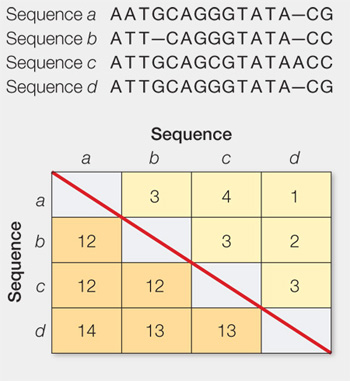recap
23.1 recap
The genomes of all organisms evolve over time. Evolutionary changes can be detected by comparing the nucleic acid and protein sequences of different species. Experimental studies of molecular evolution under controlled conditions allow biologists to study many processes of evolution directly.
learning outcomes
You should be able to:
Align a set of sequences and create a matrix that compares the similarities and differences in the sequences.
Demonstrate why counts of nucleotide or amino acid differences between two sequences often underestimate the actual number of changes that have occurred between the sequences.
1.
Align the following sequences. Then create a matrix that compares both the number of identical nucleotides and the number of differences (including insertion and deletion events).
| Sequence a | A A T G C A G G G T A T A C G |
| Sequence b | A T T C A G G G T A T A C C |
| Sequence c | A T T G C A G C G T A T A A C C |
| Sequence d | A T T G C A G G G T A T A C G |

2.
Explain why a simple count of nucleotide differences between two sequences often underestimates the actual number of nucleotide substitutions since the sequences diverged. Use an example based on the comparison of your alignment of Sequences a and b from Question 1.
A simple count of nucleotide differences misses multiple substitutions, including coincident substitutions, parallel substitutions, and back substitutions (see Figure 23.2). Evolutionary models can be used to estimate the number of multiple substitutions that have occurred, based on the number of actual differences that are observed. For example, the second nucleotide of Sequences a and b from Question 1 exhibits a single difference between an A and T. Although a single substitution from a T to an A in Sequence a could explain this difference, it is also possible that there were two substitutions (e.g., first a substitution from T to C, then another from C to A). A simple count of differences misses such multiple substitutions.
We have seen that molecular evolutionists can directly observe the evolution of genomes over time, compare the genomes of different organisms, and reconstruct the changes that have occurred during their evolution. Let’s turn now to the question of how genomes change, and examine some of the consequences of those changes.